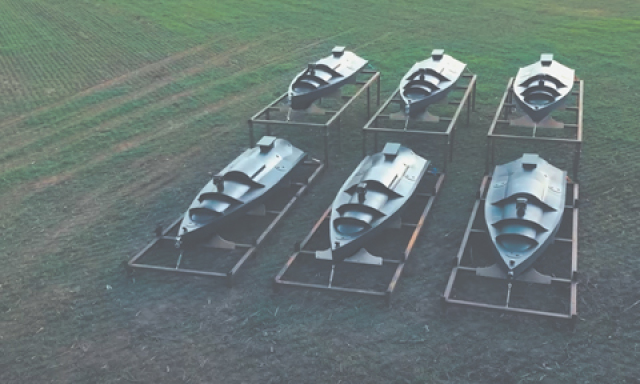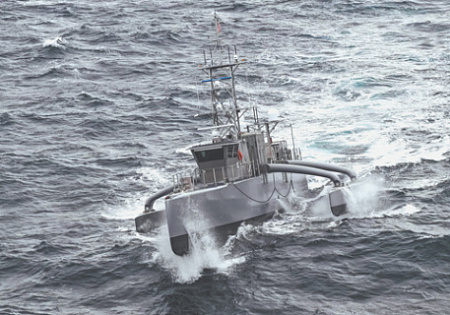The Russian Federation is lagging far behind in the creation of unmanned marine systemsMarine unmanned systems are in the shadow of similar flying vehicles, that is, drones.
Nevertheless, they are also developing very actively within the general trend of creating "deserted" combat systems.
As in the case of unmanned aerial vehicles (UAVs), marine drones are divided into reconnaissance and combat. Moreover, in this case, intelligence systems first appeared. In addition, in accordance with the marine specifics, the systems are divided into underwater (" From exploration to tsunami ", see "NWO" from 12.08.22) and surface.
Unmanned surface ships and boats can be controlled remotely in a constant mode – if there were no technical failures or the enemy did not use effective means of electronic warfare (EW). Therefore, they are much easier than underwater vehicles to include in modern network-centric control systems. Of course, surface unmanned vehicles cannot have the same level of stealth as underwater ones. But they have much fewer restrictions in terms of weight and size characteristics.
The tasks for surface vehicles are about the same as for submarines: various types of reconnaissance, the fight against mines and with submarines (submarines) of the enemy. To this may be added the fight with similar enemy vehicles, as well as with "traditional" ships or at least with boats.
The radical difference between underwater and surface unmanned vehicles is in speed.
If for the former it almost never reaches even 10 knots (with the exception of the Russian nuclear Poseidon), then for the latter it is obviously higher than 20 knots, and in some cases exceeds 40 knots.
In particular, the speed of 40 knots has an Israeli remotely controlled boat "Protector", equipped with a machine gun and an automatic grenade launcher, the possibility of using Spike missiles from it is being worked out. Its task is to protect territorial waters and the coast from enemy boats and saboteurs. The speed of 32 knots is developed by the Israeli unmanned boat "Sea Gull", designed to combat submarines and mines.
The main developers of unmanned surface vehicles are currently the United States and China.
AMERICAN AMBITIONSSo, in the USA, according to the same concept as the Israeli "Protector", the boats "Sea Oul" and "Spartan Scout" were developed.
Their maximum speed reaches 45-50 knots. It is armed with machine guns and/ or 30 mm cannons, anti-tank missile systems (ATGMs) "Hellfire" and "Javelin", as well as, possibly, anti-mine underwater vehicles. The length of these boats ranges from 4 to 11 m, displacement from 700 kg to 2.3 tons.
The Sea Hunter trimaran boat has a much larger size: length 40 m, displacement 145 tons. Its diesel engines provide the vehicle with a maximum speed of 27 knots and a huge cruising range of up to 10 thousand miles. At a speed of 8 knots, the cruising range reaches 23 thousand miles – more than the length of the equator. In practice, the boat has already made the transition from the Pacific coast of the USA to Hawaii and back.
The Sea Hunter is designed to solve anti-submarine defense (ASW) tasks, for which it carries powerful sonar systems (GAS) and magnetometers (in the absence of weapons). It is assumed that the boat should conduct patrols in the ocean for several months, monitoring the underwater situation.
Although the Sea Hunter can maintain constant communication with the control center, it must spend most of the voyage in completely autonomous mode. However, it is not very clear to what extent a ship that does not have weapons is actually capable of solving the tasks of combating modern submarines.

Marine drone hulls that are used by Ukraine to attack Sevastopol. A frame from a video from the UNITED24 channel on Youtube It is planned to create even larger unmanned boats or even full-fledged ships (at least of the corvette class, but rather of the frigate class with a displacement of up to 2 thousand tons) of universal purpose, carrying various weapons (primarily, of course, missile) and equipment.
Moreover, the number of such ships should be large enough, otherwise their construction hardly makes sense.
All this is done within the framework of the concept of "distributed (or dispersed) maritime operations". According to this concept, by the 2040s - 2050s, the US Navy should have from 90 to 180 unmanned surface ships and boats (and 50-60 unmanned underwater vehicles). This concept assumes a significant increase in the number of ships of the American fleet. However, traditional ships are already too big, expensive and vulnerable, and in the future these disadvantages will probably only increase. Hence the desire to partially replace conventional ships with much cheaper marine robots.
Unmanned vehicles should strike enemy communications, block their naval bases (naval bases). This will reduce losses in traditional ships and, accordingly, in their crews. However, the final concept of such ships has not yet been worked out, and the Sea Hunter remains the largest unmanned surface ship in the United States. Both built "Sea Hunter" are now combined into an experimental flotilla with a destroyer of the type "Zamvolt".
The CUSV boat will be designed to combat mines.
CHINESE PACKSChina has developed the "Sea Fly" apparatus, which is a small boat (such as the aforementioned "Protector" and "Spartan Scout").
It has a speed of up to 45 knots, can be armed with a machine gun and ATGM, while carrying a small UAV.
The M75 boat has similar tactical and technical characteristics (TTX), designed to solve coast guard tasks. The M80 series of devices designed for hydrographic research for military and civilian purposes have approximately the same dimensions. In particular, the M80V worked in Antarctica in 2017.
The JARI-USV boat has larger dimensions (length 15 m, displacement 20 t). It is equipped with a 30-mm cannon, a torpedo tube and even a vertical launch system for eight missiles.
The boat C1500 carries a torpedo and an underwater vehicle with GAS.
As in the USA, a number of larger unmanned boats and ships are being developed to solve various tasks, primarily anti–submarine defense. In particular, the unmanned trimaran D3000 carries four 30-mm Toure 730 cannons, as well as torpedo tubes and PU of various missiles.
In May 2018, in the South China Sea, the PLA Navy demonstrated the actions of a "flock" of 56 unmanned boats (obviously of the "Sea Fly" type). The boats carried out complex long-term joint maneuvering. In the USA, only four unmanned boats have been able to carry out such joint actions so far.
As you know, China previously had a huge mosquito fleet, which is now clearly losing relevance ("The Mosquito Fleet is a thing of the past ", "HBO", 03.09.21). First of all, this is because Chinese boats and corvettes are simply outdated. However, China will need small units both in the Battle for Taiwan (" Battle of the Titans ", "HBO", 06/19/20) and battles in Southeast Asia (" China, Indonesia, Philippines: Great Friendship or Big War? ", "HBO", 08/26/12).
Having become one of the world leaders in the development of UAVs for a long time, China does not want to lag behind in the creation of marine robots (" Technologies of deserted war ", "HBO", 05/21/2011). It is, of course, much easier to create a small unmanned boat than a large ship. At the same time, the experience of creating boats can be successfully used when creating ships. Therefore, the Chinese, moving systematically and progressively, are quite capable of bypassing overly ambitious Americans.
Anyway, if the battles of marine robots are destined to happen, then almost certainly they will happen between American and Chinese deserted ships, boats and underwater vehicles.
and othersThe achievements of Israel in the creation of unmanned vehicles were mentioned above.
There they are still exclusively small boats, designed primarily to fight "their own kind".
In Singapore, where they work according to Israeli concepts, the USV boat with a displacement of 30 tons, equipped with two 12.7 mm machine guns, is being tested, its speed reaches 30 knots.
In France, a nine-meter mine-resistant unmanned boat "Inspector" has been created with a water jet propulsion that provides a speed of up to 35 knots. It can carry underwater mine countermeasures on board. The Russian Navy previously purchased four "Inspectors" to equip the project 12700 minesweepers under construction.
At the same time, Russia is developing several of its own unmanned boats. For example, devices of the "Puffer" type are designed to collect meteorological and hydrographic information, while communication with nuclear submarines (PLA), including strategic missile submarines (RPK CH), is carried out through them.
But in general, we are very seriously lagging behind the United States and China, and Israel too. That is, the story of unmanned aerial vehicles is completely repeated.
If Russia has certain achievements in the creation of underwater autonomous vehicles, then developments on surface vehicles are still in their infancy. Unfortunately, the proverb "until the thunder breaks, the man will not cross himself" has been relevant for centuries.
Apparently, we will have to, as in the case of flying robots, run into the results of our lag in the course of some real conflict, incur unnecessary losses because of this, and then feverishly begin to catch up.
Actually, surface drones of unknown origin, which regularly visit the harbor of Sevastopol, hint this to us more than frankly. And girls with Kalashnikovs may not be enough to destroy them one day.
The mass deployment of unmanned surface vehicles can no less strongly affect the nature of naval warfare than the development of their underwater "colleagues". And, apparently, China will achieve the greatest success in their development. Thus, it will ensure at least the isolation of its territorial waters and coast from the invasion of any enemy.
American ambitions to create a large fleet of large unmanned ships will be much more difficult to realize – but, of course, it is by no means impossible.
We in Russia do not dream of either American, Chinese, or even Israeli variants yet.
Alexander KhramchikhinAlexander Anatolyevich Khramchikhin is an independent military expert.

